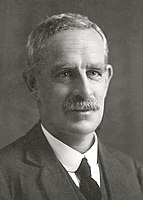| ||||||||||||||||||||||||||||||||||
All 75 seats in the House of Representatives 38 seats were needed for a majority in the House 19 (of the 36) seats in the Senate | ||||||||||||||||||||||||||||||||||
|---|---|---|---|---|---|---|---|---|---|---|---|---|---|---|---|---|---|---|---|---|---|---|---|---|---|---|---|---|---|---|---|---|---|---|
| Registered | 2,849,862 | |||||||||||||||||||||||||||||||||
| Turnout | 1,977,843 (71.59%)[a] ( | |||||||||||||||||||||||||||||||||
| ||||||||||||||||||||||||||||||||||
 Results by division for the House of Representatives, shaded by winning party's margin of victory. | ||||||||||||||||||||||||||||||||||
| ||||||||||||||||||||||||||||||||||
The 1919 Australian federal election was held on 13 December 1919 to elect members to the Parliament of Australia. All 75 seats in the House of Representatives and 19 of the 36 seats in the Senate were up for election. The incumbent Nationalist Party government won re-election, with Prime Minister Billy Hughes continuing in office.
The 1919 election was the first held since the passage of the Commonwealth Electoral Act 1918, which introduced preferential voting for both houses of parliament – instant-runoff voting for the House of Representatives and preferential block voting for the Senate. It was held several months earlier than constitutionally required, so that the government could capitalise on the popularity of Hughes after his return from the Paris Peace Conference. The Nationalists campaigned on the government's war record and appealed to return soldiers. The Australian Labor Party (ALP), in opposition since the 1916 party split, contested a second election under the leadership of Frank Tudor. However, T. J. Ryan was the party's national campaign director and played a key role in the campaign.
The Nationalists won 37 out of the 75 seats in the House of Representatives, including the seat of Ballaarat by a single vote. Labor won 26 seats, a net gain of four. The Nationalists also swept the Senate for a second consecutive election, leaving the ALP with just a single senator, Albert Gardiner. The election was notable for the emergence of the Country Party as a national political force. A referendum was held simultaneous to the election, at which the government unsuccessfully sought approval to amend the constitution for increased government powers over commerce.
Cite error: There are <ref group=lower-alpha> tags or {{efn}} templates on this page, but the references will not show without a {{reflist|group=lower-alpha}} template or {{notelist}} template (see the help page).

